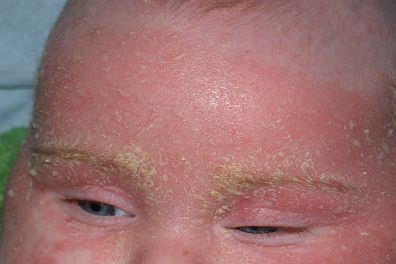Seborrheic Dermatitis
What is Seborrheic Dermatitis?
 It is an inflammatory condition of the skin that causes greasy, white, flaky scaling over red patches. It may itch, but it is usually not painful, unless infected or irritated. Seborrheic dermatitis often affects the scalp. The mild form is called dandruff. When it appears in infants, it is called cradle cap. It can also affect the skin on other parts of the body, such as the face (eyebrows, eyelids, and forehead), chest, and the creases of the neck, arms, legs, and groin.
It is an inflammatory condition of the skin that causes greasy, white, flaky scaling over red patches. It may itch, but it is usually not painful, unless infected or irritated. Seborrheic dermatitis often affects the scalp. The mild form is called dandruff. When it appears in infants, it is called cradle cap. It can also affect the skin on other parts of the body, such as the face (eyebrows, eyelids, and forehead), chest, and the creases of the neck, arms, legs, and groin.
Seborrheic dermatitis is a chronic condition that is often characterized by long periods of inactivity. During active phases, symptoms can be controlled with treatment.
Who gets Seborrheic Dermatitis?
It is a common skin condition that's often inherited. Seborrheic dermatitis most often occurs in babies younger than 3 months of age and in adults from 30 to 60 years of age. In adults, it's slightly more common in men that in women. It can disappear spontaneously and suddenly reappear, or it can linger. It does tend to reoccur.
What are the causes of Seborrheic Dermatitis?
The exact cause isn't known. Seborrheic dermatitis occurs when a certain part of your skin that has oil-producing glands becomes inflamed. It may be caused by a yeast infection of the skin, but it is not considered contagious.
This yeast-like fungus is normally present in the skin. Sometimes, it multiplies in volume, resulting in the development of seborrheic dermatitis. It may be related to hormones, because the disorder often appears in infancy, disappears in childhood and then reappears after puberty.
Seborrheic dermatitis has also been linked in adults to neurologic disorders such as Parkinson's disease, stroke, and epilepsy. The reason for this relationship isn't known.
How is Seborrheic Dermatitis treated?
Seborrheic dermatitis is a stubborn skin condition. Fortunately, it can be treated and controlled, although there is not a cure, yet. The treatment depends on the location on your body and on the age of the person.
Here are some things you can start doing to help your skin feel better:
- Avoid hot, humid weather or cold, dry weather
- Shampoo frequently with antifungal shampoo (Nizoral, Head & Shoulders, Selsun, or others)
- Dry skin folds thoroughly after bathing
- Wear loose, ventilating clothing